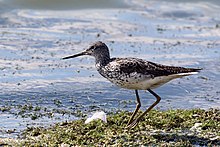The common greenshank (Tringa nebularia) is a wader in the large family Scolopacidae, the typical waders. The genus name Tringa is the Neo-Latin name given to the green sandpiper by Aldrovandus in 1599 based on Ancient Greek trungas, a thrush-sized, white-rumped, tail-bobbing wading bird mentioned by Aristotle. The specific nebularia is from Latin nebula "mist". Like the Norwegian Skoddefoll, this refers to the greenshank's damp marshy habitat.[2]
| Common greenshank | |
|---|---|

| |
| Summer plumage, Standlake, Oxfordshire | |

| |
| Winter plumage, Bahrain | |
| Scientific classification | |
| Domain: | Eukaryota |
| Kingdom: | Animalia |
| Phylum: | Chordata |
| Class: | Aves |
| Order: | Charadriiformes |
| Family: | Scolopacidae |
| Genus: | Tringa |
| Species: | T. nebularia
|
| Binomial name | |
| Tringa nebularia (Gunnerus, 1767)
| |

| |
| Range of T. nebularia Breeding Non-breeding Passage Vagrant (seasonality uncertain)
| |
| Synonyms | |
| |
Relatives edit
Its closest relative is the greater yellowlegs, which together with the spotted redshank form a close-knit group. Among them, these three species show all the basic leg and foot colours found in the shanks, demonstrating that this character is paraphyletic.[3] They are also the largest shanks apart from the willet, which is altogether more robustly built. The greater yellowlegs and the common greenshank share a coarse, dark, and fairly crisp breast pattern as well as much black on the shoulders and back in breeding plumage.[citation needed]
Distribution edit
This is a subarctic bird, breeding from northern Scotland eastwards across northern Europe and east across the Palearctic. It is a migratory species, wintering in Africa, the Indian subcontinent, and Australasia, usually on fresh water. It breeds on dry ground near marshy areas, laying about four eggs in a ground scrape.[citation needed]
Description edit
Common greenshanks are brown in breeding plumage, and grey-brown in winter. When in water, they can appear very similar to marsh sandpipers but are distinguished by the shape of the lower bill which gives it an upturned appearance to the bill. They have long greenish legs and a long bill with a grey base. They show a white wedge on the back in flight. They are somewhat larger than the related common redshank. The usual call is a rapid series of three short fluty notes syllabilized as teu-teu-teu.[citation needed]
Like most waders, they feed on small invertebrates, but will also take small fish and amphibians.[citation needed]
The common greenshank is one of the species to which the Agreement on the Conservation of African-Eurasian Migratory Waterbirds (AEWA) applies.[citation needed] In 2024, T. nebularia was listed as Endangered under the Australian EPBC Act.[4]
Gallery edit
-
Juvenile
-
Manly Marina, SE Queensland, Australia
-
Egg, Collection Museum Wiesbaden
-
Common greenshank is significantly larger than, for example Common redshank.
References edit
- ^ BirdLife International (2016). "Tringa nebularia". IUCN Red List of Threatened Species. 2016: e.T22693220A86684205. doi:10.2305/IUCN.UK.2016-3.RLTS.T22693220A86684205.en. Retrieved 12 November 2021.
- ^ Jobling, James A (2010). The Helm Dictionary of Scientific Bird Names. London: Christopher Helm. pp. 266, 390. ISBN 978-1-4081-2501-4.
- ^ Pereira, S.L.; Baker, A.J. (2005). "Multiple Gene Evidence for Parallel Evolution and Retention of Ancestral Morphological States in the Shanks (Charadriiformes: Scolopacidae)". Condor. 107 (3): 514–526. doi:10.1650/0010-5422(2005)107[0514:MGEFPE]2.0.CO;2. S2CID 86221767.
- ^ "Tringa nebularia — Common Greenshank, Greenshank". Species Profile and Threats Database. Australian Department of Climate Change, Energy, the Environment and Water. 5 January 2024. Retrieved 6 March 2024.
External links edit
- (Common) greenshank species text in The Atlas of Southern African Birds
- Ageing and sexing (PDF; 1.2 MB) by Javier Blasco-Zumeta & Gerd-Michael Heinze
- BirdLife species factsheet for Tringa nebularia
- "Tringa nebularia". Avibase.
- "Common greenshank media". Internet Bird Collection.
- Common greenshank photo gallery at VIREO (Drexel University)
- Interactive range map of Tringa nebularia at IUCN Red List maps
- Audio recordings of Common greenshank on Xeno-canto.
- Tringa nebularia in Field Guide: Birds of the World on Flickr
- Common greenshank media from ARKive
